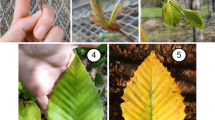Abstract
The response of theCeutorhynchus assimilis antenna to volatiles in air entrainment-derived extracts of oilseed rape,Brassica napus, was studied using coupled gas chromatography (GC)-electroantennography (EAG) and coupled GC-single cell recording (SCR). By means of these techniques and coupled gas chromatography-mass spectrometry (GC-MS), 25 active compounds were identified, including isoprenoids and compounds derived from fatty acids and amino acids. Some of the latter, the isothiocyanates and goitrin, and probably indole and benzyl cyanide, are catabolites of glucosinolates. The electrophysiological activity of the identified compounds was confirmed by EAG using a physiologically discriminating dose, and by SCR studies. The importance of the combined use of the EAG and SCR techniques was demonstrated, since specific olfactory cells were located for five compounds that did not elicit significant EAG responses. The majority of the olfactory cells from which single cell recordings were obtained showed very high specificity, and in numerous recordings there were consistent pairings of specific cell types.
Similar content being viewed by others
References
Alford, D.V., Cooper, D.A., andWilliams, I.H. 1991. Insect pests of oilseed rape.HGCA Oilseeds Research Review No. OSI.
Anon. 1994. Agricultural Statistics in the United Kingdom, 1993. HMSO, London.
Bartlet, E., Blight, M.M., Hick, A.J., andWilliams, I.H. 1993. The responses of the cabbage seed weevil (Ceutorhynchus assimilis) to the odour of oilseed rape (Brassica napus) and to some volatile isothiocyanates.Entomol. Exp. Appl. 68:295–302.
Blight, M.M. 1990. Techniques for isolation and characterization of volatile semiochemicals of phytophagous insects, pp. 281–288,in A.R. McCaffery and I.D. Wilson (eds.). Chromatography and Isolation of Insect Hormones and Pheromones. Plenum Press, New York.
Blight, M.M., Pickett, J.A., Wadhams, L.J., andWoodcock, C.M. 1989. Antennal responses ofCeutorhynchus assimilis andPsylliodes chrysocephala to volatiles from oilseed rape.Aspects Appl. Biol. 23:329–334.
Blight, M.M., Hick, A.J., Pickett, J.A., Smart, L.E., Wadhams, L.J., andWoodcock, C.M. 1992. Volatile plant metabolites involved in host-plant recognition by the cabbage seed weevil,Ceutorhynchus assimilis, pp. 105–106,in S.B.J. Menkin, J.H. Visser, and P. Harrewijn (eds.). Proceedings 8th International Symposium on Insect-Plant Relationships. Kluwer Academic Publishers, Dordrecht.
Boeckh, J. 1962. Elektrophysiologische Untersuchungen an einzelnen Geruchs-Rezeptoren auf den Antennen des Totengräber (Necrophorus, Coleoptera).Z. Vergl. Physiol. 46:212–248.
Bonnemaison, L. 1957. Le charançon des siliques (Ceuthorrhynchus assimilis Payk.). Biologie et méthodes de lutte.Ann. Inst. Natl. Recherche Agron. Ser. C. 8:387–543.
Dawson, G.W., Doughty, K.J., Hick, A.J., Pickett, J.A., Pye, B.J., Smart, L.E., andWad hams, L.J. 1993. Chemical precursors for studying the effects of glucosinolate catabolites on diseases and pests of oilseed rape (Brassica napus) or related plants.Pestic. Sci. 39:271–278.
Evans, K.A., andAllen-Williams, L.J. 1989. The response of the cabbage seed weevil (Ceutorhynchus assimilis Payk.) and the brassica pod midge (Dasineura brassicae Winn.) to flower colour and volatiles of oilsced rape.Aspects Appl. Biol. 23:347–353.
Evans, K.A., andAllen-Williams, L.J. 1992. Electroantennogram responses of the cabbage seed weevil,Ceutorhynchus assimilis, to oilseed rape,Brassica napus ssp.oleifera, volatiles.J. Chem. Ecol. 18:1641–1659.
Fenwick, G.R., Heaney, R.K., andMullin, W.J. 1983. Glucosinolates and their breakdown products in food and food plants.CRC Crit. Rev. Food Sci. Nutr. 18:123–201.
Free, J.B., andWilliams, I.H. 1978. The responses of the pollen beetle,Meligethes aeneus, and the seed weevil,Ceuthorhynchus assimilis to oilseed rape,Brassica napus, and other plants.J. Appl. Ecol. 15:761–764.
Görnitz, K. 1953. Untersuchungen über in Cruciferen enthaltene Inskten-Attraktivstoffe.Nachrichtenbl. Dtsch. Pflanzenschutzdienst 7:81–95.
Heaney, R.K., andFenwick, G.R. 1987. Identifying toxins and their effects: Glucosinolates, pp. 76–109,in D.H. Watson (ed.). Natural Toxicants in Food-Progress and Prospects. VCH Pubs, Weinheim.
Isidoro, N., andSolinas, M. 1992. Functional morphology of the antennal chemosensilla ofCeutorhynchus assimilis Payk. (Coleoptera: Curculionidae).Entomol. Bari 27:69–84.
Jakobsen, H.B., Frhs, P., Nielsen, J.K., andOlsen, C.E. 1994. Emission of volatiles from flowers and leaves ofBrassica napus in situ.Phytochemistry 37:695–699.
Kozlowski, M.W. 1984. Selective responsiveness of the antennal olfactory system in the cabbage seed weevil,Ceutorhynchus assimilis towards host plant volatiles.Acta Physiol. Pol. 35:577–579.
Maddrell, S.H.P. 1969. Secretion by the Malpighian tubules ofRhodnius. The movement of ions and water.J. Exp. Biol. 51:71–97.
Murray, K.E. 1969. α-Farnesene: Isolation from the natural coating of apples.Aust. J. Chem. 22:197–204.
Pham-Delegue, M.H., Blight, M.M., Le Métayer, M., Marion-Poll, F., Picard, A.L., Pickett, J.A., Wadhams, L.J., andWoodcock, C.M. 1992. Plant chemicals involved in honeybee-rapeseed relationships: Behavioural, electrophysiological and chemical studies, pp. 129–130,in S.B.J. Menken, J.J. Visser, and P. Harrewijn (eds.). Proceedings, 8th International Symposium on Insect-Plant Relationships. Kluwer Academic Publishers, Dordrecht.
Pickett, J.A. 1990. Gas chromatography-mass spectrometry in insect pheromone identification: three extreme case histories, pp. 299–309,in A.R. McCaffery and I.D. Wilson (eds.). Chromatography and Isolation of Insect Hormones and Pheromones. Plenum Press, New York.
Robertson, G.W., Griffiths, D.W., Macfarlane Smith, W., andButcher, R.D. 1993. The application of thermal desorption—gas chromatography-mass spectrometry to the analyses of flower volatiles from five varieties of oilseed rape (Brassicae napus spp.oleifera).Phytochem. Anal. 4:152–157.
Smart, L.E., Blight, M.M., andHick, A.J. 1993. Development of a monitoring system for the cabbage seed weevil and the pollen beetle, pp. 351–354,in L.J. McVeigh, D.R. Hall, and P.S. Beevor (eds.). Bulletin OILB/SROP 16(10).
Tollsten, L., andBergström, G. 1988. Headspace volatiles of whole plants and macerated plant parts ofBrassica andSinapis.Phytochemistry 27:4013–4018.
U.N. 1935. Genome analysis in the Brassicae, with special reference to the experimental formation ofBrassica napus.Jpn. J. Bot. 7:389–452.
Visser, J.H. 1986. Host odor perception in phytophagous insects.Annu. Rev. Entomol. 31:121–144.
Wadhams, L.J. 1990. The use of coupled gas chromatography: electrophysiological techniques in the identification of insect pheromones, pp. 289–298,in A.R. McCaffery and I.D. Wilson (eds.). Chromatography and Isolation of Insect Hormones and Pheromones. Plenum Press, New York.
Wadhams, L.J., Angst, M.E., andBlight, M.M. 1982. Responses of the olfactory receptors ofScolytus scolytus (F.) (Coleoptera: Scolytidae) to the stereoisomers of 4-methyl-3-heptanol.J. Chem. Ecol. 8:477–492.
Author information
Authors and Affiliations
Rights and permissions
About this article
Cite this article
Blight, M.M., Pickett, J.A., Wadhams, L.J. et al. Antennal perception of oilseed rape,Brassica napus (Brassicaceae), volatiles by the cabbage seed weevilCeutorhynchus assimilis (Coleoptera, Curculionidae). J Chem Ecol 21, 1649–1664 (1995). https://doi.org/10.1007/BF02033667
Received:
Accepted:
Issue Date:
DOI: https://doi.org/10.1007/BF02033667




